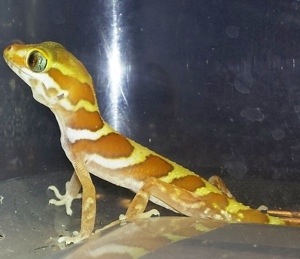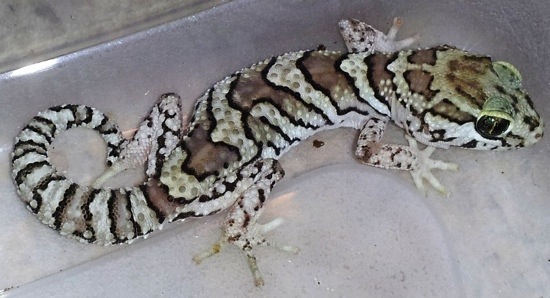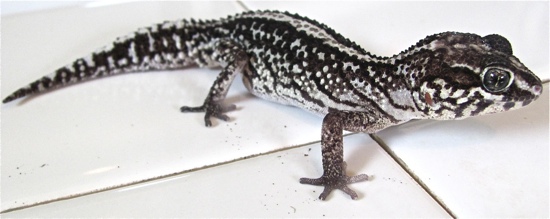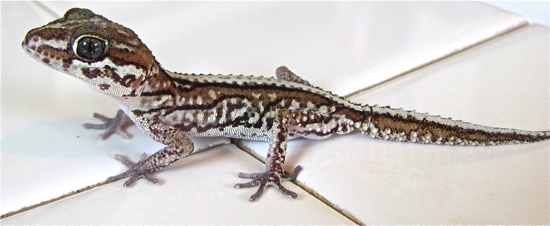[ad#300]
Although, according to wikipedia, there are 16 species in the Paroedura genus, Paroedura picta is by far the most popular to be kept in the reptile hobby, as you will see below. The three Paroedura keepers have all, once again, responded to the following questions:
- What species are you keeping?
- What got you interested in this species and where did you get your first?
- How are they set up? Describe your enclosure.
- What do you find most interesting about them?
- What do you find to be the biggest challenge?
Cory VanHoose
I have been working with and keeping Paroedura Picta, formerly known as Paroedura Pictus. Common names for Paroedura Picta are Pictus Gecko, Panther Gecko, Ocelot Gecko, Big Head Gecko, and Madagascar Ground Gecko. I have also seen some call it a Picta Gecko before but not as often. I personally refer to them as Pictus or Panther Geckos because those seem to be the most widely known of the common names.
Pictus geckos are a smaller terrestrial or ground dwelling species that live on the forest floor of Madagascar, typically among the leaf litter. They are nocturnal insectivores and can be sustained on a diet of crickets and mealworms in captivity. Pictus geckos only get to be about 4-6 inches long and weighing about 15-20 grams on average, although I have one that is about 7 inches and weighing in at nearly 30 grams, so they can get a bit bigger but that is not typical.
Pictus gecko morphs haven’t been completely agreed upon or tested in the reptile community yet based on the research I have conducted. There are several variations though, such as Anerythristic, Xanthic, and Normal. There is also an albino strain that has been mislabeled as being Xanthic which I have acquired and reproduced but I’m still not completely sure if it is a T+ or T- strain although I am positive it is recessive as seen in many other species. There are also people working on different lines such as stripes, high reds, and even a possible snow morph. The future should be quite interesting for these little geckos and their possible morphs.
I became interested in these guys because I saw one in a pet store a few years ago and thought they appeared very interesting. I started doing research to learn more about them which just fueled my fascination with them as I found out that they were somewhat difficult to find but the interest within the community was definitely there. Just the possibilities of what could come from working with these guys was interest enough for me.
I purchased my few Pictus babies in 2010 from Kim Bell at Reptmart. They were one of the only breeders that I knew who were working with them and had them available for purchase. I raised those babies up and added new ones whenever I could which led me to have the small colony I have now. I have also purchased a few from Julie at Gecko Ranch.
There are of course several different types of set ups you can do with Pictus geckos. The main things to consider are heat and humidity. I have all my breeding females in 10 gallon tanks lined with paper towel to retain moisture with tile on top of that. I have found that the tile maximizes heat distribution and maintains a more constant temperature from the under tank heater. I use a cave on the hot side and another hide that holds substrate (50/50 ratio of crushed peat moss and vermiculite) that is used as a nesting box and a moist hide. I also put a magnetic ledge in the tank for them to climb on but I don’t put it too high since they have a habit of jumping off the ledge and I don’t want them to get hurt. I can keep up to 2 females in this type of set up and introduce a male periodically throughout the breeding season. Finally I have a dish of water, a dish of calcium, and a dish for mealworms in there as well.
I keep all my breeder males in separate 15 quart Sterilite tubs with lids and the 50/50 ratio of crushed peat moss and vermiculite is used as substrate. This retains the needed humidity but is not an expanding substrate or sand so it won’t hurt them if they snag some when eating crickets. I have one cave hide on the warm side of the tub. I use the same sized dishes for water and mealworms as in the tanks but I do not use calcium dishes for the males unless they need extra for some reason.
The babies and juveniles I keep in a 6 quart Sterilite tub with a lid. I can keep 2 or more in these tubs depending on the size of the gecko. If they are babies then I keep them on paper towels and once they get to be about 7-10 grams or so I put them on the substrate. Paper towels are easier for the babies to learn to hunt prey on than the substrate. I use upside down plant pot trays that have a hole cut in them for hides in these smaller tubs. I use the same mealworm dish but use a smaller water dish, usually just some sort of bottle cap.
All of the geckos get fed and their enclosures get misted and spot cleaned every other day unless more is needed.
I find the Pictus gecko interesting because they are highly curious critters. I catch them poking their heads out of their hides all the time just watching what I am doing even if I’m not working in their cage. Sometimes they even just sit on the highest point in their enclosure trying to figure me out. It is quite entertaining and I often wonder what they are thinking. These guys are also very active, agile, and fast. It is often tough to catch them because if you blink they are gone but yet once you catch them they are often very docile and don’t seem to mind short stints of being handled. It is also quite entertaining to watch them during meal time because they seem to be ambush hunters and come out of nowhere when a cricket is just walking around.
Overall I find many different aspects of the Pictus gecko to be interesting and entertaining from their potential color variants to their individual personalities.
The biggest challenge that I have faced with breeding the Pictus gecko is their eggs. Pictus gecko eggs are small with extremely thin shells that are very fragile. They also seem to lay a lot of infertile eggs. I have added a constant supply of calcium and it has helped but not eliminated the problem. It happens quite often that when the geckos lay the eggs they either step on them or the egg has a stress fracture from the laying process, so during incubation when the egg starts to swell it opens the crack up and the egg has to be tossed. This is quite frustrating but from consulting others it is normal. Fortunately they lay a lot of eggs, 1-2 per 7-10 days, throughout the season. Right now I have a couple of females that have laid about 30 eggs so far. This kills the lay to hatch ratio but not much can be done except to take them out of the enclosure ASAP and provide extra calcium.
Other than the egg issue I haven’t run into too many complications that are specific to Paroedura Picta. They are quite hardy little guys that are fun to watch and make an awesome addition to any collection.
Derek Vera
I am currently keeping Paroedura Picta. These ground dwelling geckos are native to the island of Madagascar and are typically found in forest leaf litter. They have the most common names out of any gecko I have dealt with: Panther Gecko, Ocelot Gecko, Madagascar Big Headed Gecko, Madagascar Ground Gecko, or Madagascar Fat Tailed Gecko.
I first became interested in P. Picta shortly after joining the Geckos Unlimited forum in 2010. After searching through the threads I came across several that contained info on these little guys and I instantly fell in love. It was later that year that I found a trio at a local pet store for a very good price. I jumped on this opportunity. I had a 1.1 striped and 0.1 banded. It was not long before I had my first eggs and was amazed by how tiny the hatchlings were.
My P. Picta are set up somewhat naturally. I keep my adult pairs in 28 quart tubs. In their enclosures I provide multiple hides made from plastic dishes placed upside down with a hole cut for entry. In their enclosures I also have a few artificial plants and this is just to make it a little more appealing for me. For substrate I use coconut fiber. In the habitat I also keep a shallow dish of spring water and a dish of pure calcium so the females can consume as they please. I find calcium is more important to this gecko than any other species I am currently keeping. I maintain their humidity level between 50 and 60% with a temperature around 86 degrees. Their diet consists of a combination of crickets, mealworms, and Dubia roaches.
The things I find most interesting about this species is their huge personalities and how inquisitive they can be.
My biggest challenge in keeping this species was collecting eggs from the enclosures. In the beginning I was used to collecting eggs from my Leopard Geckos which lay soft durable eggs unlike those of Paroedura Picta that are hard shelled, delicate eggs. I then learned that it was best to use a soft brush to move the substrate away carefully and began to use a small plastic spoon to scoop up the eggs and place them into the containers to incubate.
Sarah Dickenson
I keep Pictus (Panther) Gecko aka Paroedera Picta.
I received my first ones from a fellow breeder and good friend. I was interested in them because they seemed quite different from any other species I had kept at that point and knew them to be considered an interesting species.
At the moment I am only keeping a single pair. I house them separately 90% of the year, each in a 10 gallon tank. The tank is decorated with two hides, one filled with sphagnum moss for lay areas as well as to aid with the shedding process. Also I include a few sticks and fake plants to allow them other places for hiding and climbing. At all times they have a full water dish and a small container full of calcium.
I love the blatant curiosity they display. They come out anytime I’m in my gecko room at night and watch me going about my chores. My male seems to love to run about while I’m misting his cage. When he hears the spray bottle he comes shooting out of any hide he may be in and makes a run about the cage. I jokingly call it his rain dance. It’s very entertaining to watch.
Pictus really need higher ambient humidity but dry surfaces. Living in a high altitude desert I have a harder time maintaining this because my local humidity will dip down into the teens on a regular basis. I fix this problem by lightly misting the tanks at least two times a day as well as always running a humidifier in my gecko room.
The other challenge with them can be getting the female to stop laying eggs and not letting them breed themselves to death. Last year I had a problem with one of my females laying a set of eggs every 8 days. She did this for 5 months. Unfortunately I lost her due to this. I had tried everything I could think of to get her to stop laying but it all turned out to be useless. Now I only keep the one pair and I make it a point to only start the breeding season at the end of summer so I can better time her laying eggs with the cooler months in hope of avoiding past issues.
Our Authors
Sarah Dickenson is a mother and wife living in Central Oregon. She has been keeping reptiles for over 15 years and is the owner/operator of LunarGecko.net. She is also the president and founder of Central Oregon Herpetology and supporting member of GGA, IRCF, W.O.R.K. and USARK.
Cory VanHoose owns and operates CSM Gecko as his passion and hobby. Cory has been keeping and caring for reptiles since he was very young and decided to start breeding Leopard Geckos as a fun hobby in 2008. He opened CSM Gecko in 2009 while he was still in the Navy in Ventura, CA.
In early 2010, Cory moved to Reno, NV and added Pictus Geckos, Carpet Chameleons, and Panther Chameleons to CSM Gecko. He has been growing and adding to his collection ever since. Cory is now an active member, sponsor, and newsletter writer for the Reno Herpetological Society. He plans on the continual growth of CSM Gecko and looks forward to the future. You can contact Cory at www.csmgecko.com, www.facebook.com/CSMGecko, or [email protected].
Derek Vera is 26 years old and lives right outside of Austin, TX. He has worked in the pet industry for almost 11 years and enjoys educating people on the proper care of all types of pets. He currently is working with Eublepharis Macularius, Goniurosaurus Hainanensis, Paroedura Picta, and Tribolonotus Gracilis. Along with numerous other animals and reptiles, he breeds eight different species of feeder insects to feed his collection. He recently started DVReptile (facebook.com/DVReptile) to contribute to the hobby by providing high quality reptiles.
Editor’s note: Sorry for the lack of variety in our Paroedura showcase. If you keep other species in this genus please drop us an email, we’d love to have you write a post.





























Thanks Cory, Derek and Sarah for your very interesting saga raising the cute and curious Paroedura Picta.